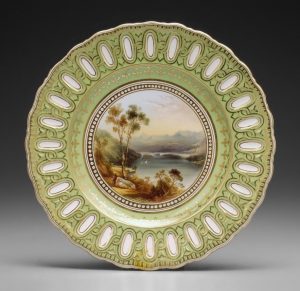Pre-Felton acquisitions included:
2 plates and 2 vases. Presented by F.G.Dalgety 1862. NGV (refer catalogue)
- Pair of covered vases (c.1879). Presented by Copeland & Sons 1880. NGV 362.a-d-D1M
- Ice pail. Purchased 1880. NGV 357-D1M
- Potpourri vase, & Écuelle and stand. Purchased 1881. NGV 354 & 355-D1M
[photo: Loch Awe plate donated by Dalgety 1862 (NGV 359-D1M)]
The famous pottery founded at Stoke-on-Trent in 1770 by Josiah Spode (1733-97) was run in partnership with William Copeland, and, after Spode’s death, by Copeland and his sons. From 1833, the business was run by William Taylor Copeland (1797-1868), and the four pieces acquired for Melbourne in 1862 date from that period.
The other objects listed above date from the subsequent period when the pottery operated as W.T.Copeland and Sons (1867ff.). The two covered vases are decorated with somewhat mawkish Ye Olde Englande scenes, suggesting a decline in quality and/or originality.
Other Copeland pieces in the NGV (catalogued without acquisition dates) may also have been acquired in the pre-Felton period; further research may prove productive on this score.
Several Parian busts produced by Copeland in the 1860s were also previously in the pre-Felton collection; see now * Copeland & Sons (after others) Prince and Princess of Wales {by 1871} Loc? [SC] and * Unknown (Copeland & Sons?) Clytie {by 1865} Loc? [SC].
Other examples, including several further busts and statuettes in Parian porcelain, were added to the NGV in 2007: for details, see online catalogue.
Refs.
Refer NGV catalogue: e.g. https://www.ngv.vic.gov.au/explore/collection/work/16693/ (359-D1M, as illustrated here); and https://www.ngv.vic.gov.au/explore/collection/artist/7750/ (pieces by W.T.Copeland and Sons, including the pair of covered vases, with reproductions). Several of the works listed above are also mentioned in the NGV’s unpublished list of pre-Felton acquisitions
For the general history, refer Wikipedia; for Spode, see Decorative Arts – Introduction (noting a Spode Amphora acquired in 1862, also with funds donated by Dalgety).

 2 plates and 2 vases. Presented by
2 plates and 2 vases. Presented by 